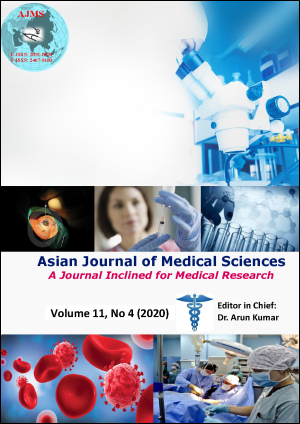Speciation and antifungal susceptibility testing of candida species isolated from clinical samples
Keywords:
Disk diffusion method, NAC, Sensitive, Predominant speciesAbstract
Background: The importance of epidemiological monitoring of yeasts involved in pathogenic processes is unquestionable due to the increase in trend of infections caused by various species of Candida over the last decade; so are the changes observed in species causing Candidiasis and empirical antifungal treatment.
Aims and Objective: To speciate the clinically isolated Candida species by phenotypic methods and to estimate the antifungal susceptibility of the isolated species against fluconazole, ketoconazole, voriconazole, itraconazole by disc diffusion method.
Materials and Methods: A cross-sectional study conducted in 2018 in the Department of Microbiology, J. N. Medical College, KAHER, Belagavi Karnataka. Ethical Clarence was obtained from institutional ethical committee J.N. Medical College.
Results: Out of 59 Candida isolates, Candida tropicalis was the predominant species 41(69.49%), followed by Candida glabrata 5 (8.47%), Candida parapsilosis and Candida lusitaniae 4 (6.78%) respectively, Candida
guilliermondii and Candida kefyr 2 (3.39%) respectively and the least one was Candida krusei 1 (1.69%). Voriconazole showed the highest level of sensitivity whereas Itraconazole has shown the least sensitivity pattern by disk diffusion method. Out of 59 Candida species, 52 (88.13%) were sensitive to Voriconazole, 44 (74.57%) were sensitive to Fluconazole, 40 (67.79%) were sensitive to Ketoconazole and the least sensitivity was shown by Itraconazole 30 (50.84%). Candida krusei and Candida guilliermondii showed 100% sensitive to Fluconazole, Voriconazole, Ketoconazole and Itraconazole respectively.
Conclusion: Non-albicans Candida species are being common isolates from cases of candidiasis. Candida tropicalis is the predominant isolate, followed by Candida glabrata, Candida lusitaniae, Candida parapsilosis, Candida guilliermondii, Candida kefyr and Candida krusei. Most of the isolates were sensitive to Voriconazole.
Downloads
Downloads
Published
How to Cite
Issue
Section
License
Authors who publish with this journal agree to the following terms:
- The journal holds copyright and publishes the work under a Creative Commons CC-BY-NC license that permits use, distribution and reprduction in any medium, provided the original work is properly cited and is not used for commercial purposes. The journal should be recognised as the original publisher of this work.
- Authors are able to enter into separate, additional contractual arrangements for the non-exclusive distribution of the journal's published version of the work (e.g., post it to an institutional repository or publish it in a book), with an acknowledgement of its initial publication in this journal.
- Authors are permitted and encouraged to post their work online (e.g., in institutional repositories or on their website) prior to and during the submission process, as it can lead to productive exchanges, as well as earlier and greater citation of published work (See The Effect of Open Access).




